From the 15th century, major European powers occupied territories on other continents. First it was the Portuguese and Spaniards, then other countries followed suit. Trade in spices and raw materials promised wealth and power. Millions of people were displaced, raped, enslaved or killed.
Portugal conquers Ceuta
From the early 15th century, the Portuguese were drawn to the sea. The geographical location on the edge of Europe, directly on the Atlantic, was a great advantage for the future seafaring nation. In 1415, an army of crusaders under Portuguese command conquered the North African city of Ceuta.
One of the most dazzling Portuguese personalities appeared for the first time:Infante Dom Henrique o Navegador, also known as Henry the Navigator. In the following decades he became the most important client of Portuguese sea voyages in the Atlantic. In 1419 Madeira was taken possession, in 1427 the Azores. Portuguese ships advanced far south along the African coast, establishing numerous bases on land along the way.
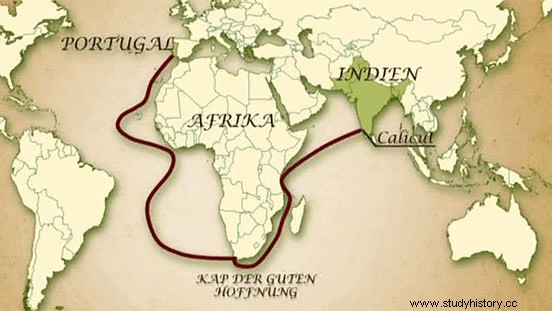 Start video, cancel with escape
Start video, cancel with escape Portugal – a seafaring nation
01:15 min. Available until 10/11/2024.
Initially, the bases served to rob people who were then taken to Portugal as slaves. Later, trade relations were also established:gold, ivory and slaves were exchanged for horses with African peoples such as the Wolof in Mauritania.
The Portuguese machinations in Africa did not go unnoticed by neighboring Spain. Fighting for the Canary Islands broke out. In 1455, Pope Nicholas V granted the Portuguese the exclusive right to navigate and occupy the Gulf of Guinea and all areas south of it. In return, the Spanish received the Canary Islands.
The Treaty of Tordesillas
Towards the end of the 15th century Spain became increasingly powerful. Through their marriage in 1469, Isabella I of Castile and Ferdinand II of Aragon united their kingdoms. In 1492, Christopher Columbus was probably the first European to set foot on American soil on behalf of the Spaniards. Spain wanted to conquer the new territories for itself, but Portuguese claims to sovereignty in the Atlantic stood in the way.
To prevent another armed conflict, the two major powers divided the world outside of Europe between themselves in the "Treaty of Tordesillas". An artificial line was drawn about 1770 kilometers west of the Cape Verde Islands. The Spaniards got the western part, the Portuguese the eastern part.
The Spaniards immediately went to work. They occupied the Caribbean islands, Hernán Cortés conquered the Aztec Empire in Mexico in 1519 and Francisco Pizarro conquered the Inca Empire in Peru in 1531.
The campaigns were driven by the greed for power and wealth. Only later did the Spanish church and the Spanish royal family claim that the conquerors were primarily concerned with Christian missionary work among the American peoples - which was also intended to justify the often brutal violence of the colonialists.
The Portuguese continued to expand their dominions in Africa. They were also very interested in keeping the lucrative spice trade with Asia in their hands. In 1498, Vasco da Gama circumnavigated the Cape of Good Hope for the first time and reached India by sea. In 1510 Goa was made the capital of the Portuguese occupied territory in India. In the decades that followed, the Portuguese controlled all trade in the Indian Ocean.
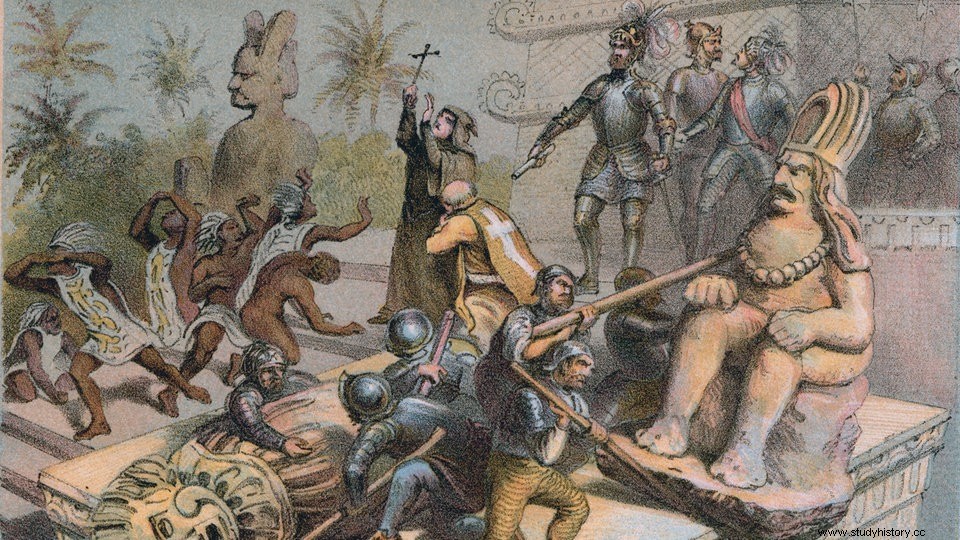
Hernán Cortés had all Aztec cultural monuments destroyed
Slave Trade Licenses
Cheap labor was wanted for the new colonies on the American continent. First, the Spaniards enslaved many indigenous workers and forced them to work on the plantations and in the mines.
In the years that followed, many locals died due to the inhumane working conditions, in mining accidents and above all from diseases such as smallpox, measles or typhus, which were brought in by the Europeans.
So the colonialists came up with the idea of bringing slaves from Africa to America. But the Treaty of Tordesillas prohibited the Spaniards from doing business on the African continent. Therefore, in 1517, King Charles V of Spain granted the first official license to trade slaves to traders from Flanders (now part of Belgium and France). From now on they were allowed to sell 4000 slaves to America every year. This laid the foundation for the exploitation of the African continent.
A lot of money could be made from the slave trade. In the years that followed, more and more Europeans received official licenses for it, the so-called "Asientos de Negros". First the Genoese and Portuguese traded in slaves, and later the English and French as well.
According to estimates, more than ten million Africans were deported to America within around 300 years.
In 1807, Britain became the first European nation to outlaw the slave trade. Slavery was then officially outlawed in the Congress of Vienna in 1815, and the transatlantic slave trade quickly lost its importance.
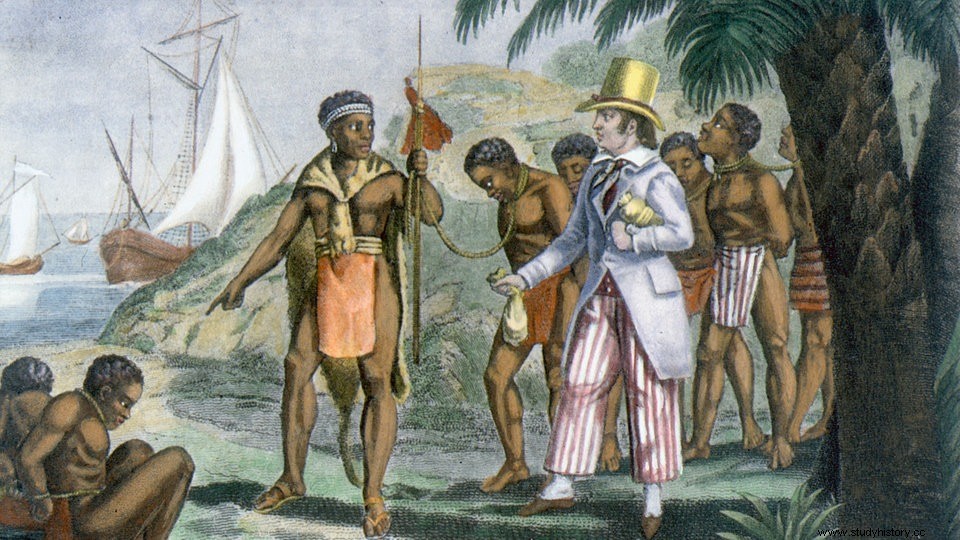
Slave trade on the west coast of Africa
The "British East India Company" and "Vereenigde Oostindische Compagnie"
In the early 17th century, the naval power of Great Britain also took up colonial plans. In North America, British emigrants settled entire areas and gradually pushed out the Indian population. In Asia, on the other hand, the British primarily focused on economic relations. The "British East India Company" was founded in London in 1600 for this purpose. She was granted the royal privilege of controlling the trade in spices, silk and cotton.
Initially, it was purely a trading company that competed with similar companies from other countries. But in the course of the 18th century, the company strove for more political power, especially in India, and conquered numerous regions. Then, in the 19th century, they controlled the entire subcontinent of India, including what is now Pakistan, Afghanistan, Burma and Malaysia.
In 1602, only two years after the British trading company was founded, the Dutch also started their expansion in Asia. While the British concentrated on India, the "Vereenigde Oostindische Compagnie" (VOC) gradually brought all of Indonesia under their economic control.
In contrast to the British, the Dutch did not conquer territories, but established trading posts such as the city of Batavia on Java. They largely left the local power structures in place, but dictated which products were traded to meet the needs of Europe. Pepper, tea, coffee and textiles were among the preferred goods.
In order to finance their ventures, the VOC invented the principle of shares. Rich Dutchmen could participate in the company and received dividend payments if the VOC made any profits.

The world's first stock - a by-product of colonization
The Founding of Quebec
In the 16th century, the French also began to conquer and colonize overseas territories. They initially focused on North America. The navigator Jacques Cartier penetrated far into the Gulf of St. Lawrence on his voyages from 1534 and took possession of the surrounding coastal areas for France. With the founding of Quebec City in 1608, French settlers began to occupy the hinterland as well.
In the decades that followed, they continued to expand their sphere of influence, but soon encountered fierce resistance from the British, who also claimed the North American territories for themselves. Fighting broke out again and again, culminating in the Seven Years' War (1756-1763) between the two major European powers.
France lost this war and had to cede all its colonies to the British in the Treaty of Paris in 1763. This ended the colonial efforts of the French for the time being.

Quebec City was founded in 1608
The American Revolutionary War
In the 18th century British rule in North America seemed to have been consolidated. Competitors France and the Netherlands were eliminated, and trade with the 13 British colonies in America flourished.
But in the 1770s the first resistance formed. The tea imported into North America was taxed so heavily that the colonies could hardly afford it. Resistance culminated in the Boston Tea Party in 1773. American settlers sank a British ship of the "East India Company" laden with tea in Boston Harbor - and demanded more self-determination for the colonies in America.
However, the British government reacted in exactly the opposite way. She closed the port of Boston and passed legislation severely restricting the colonies. But they couldn't do that. In 1775 they declared war on the mother country and proclaimed their independence on July 4, 1776.
Even though the war with the British continued for seven more years, the colonies surprisingly emerged victorious. In 1783 George Washington was elected the first President of the newly formed "United States of America". With the defeat in the American War of Independence, Great Britain had to give up its first colonies.
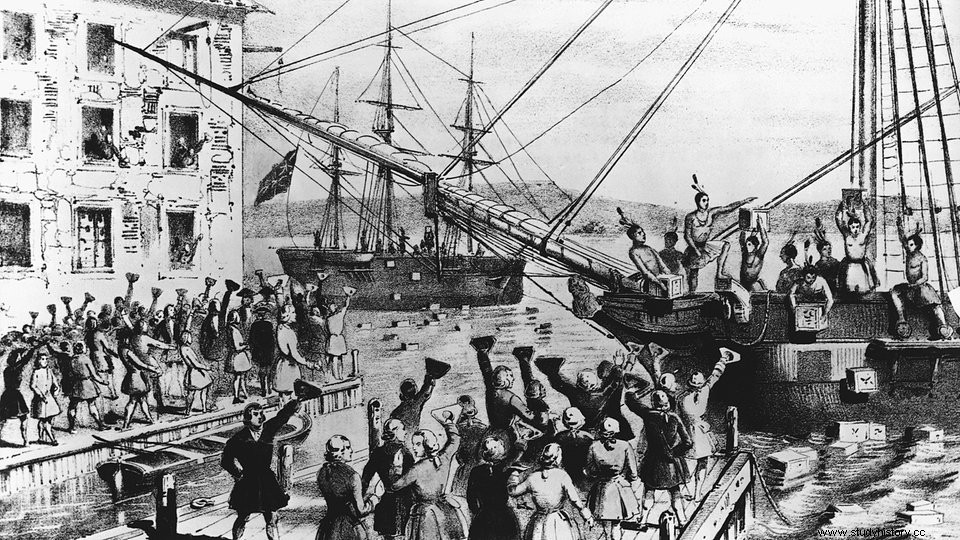
The "Boston Tea Party"
Napoleon's occupation of Egypt
Around 1800, Napoleon Bonaparte appeared for the first time - a small Corsican who changed Europe forever. As a young general in the French army, he invaded Egypt in 1798 in order to be able to challenge the British in the Mediterranean from there. France wanted to rebuild a colonial system.
So Napoleon, together with the Russians, tried to bring India under his control. He also sent troops to Persia, Syria and Algeria to scout out a possible occupation of the countries. The plans all failed.
After the fall of Napoleon, the French regained their former colonies in the "Peace of Paris" in 1814. But this small possession, spread across all oceans, seemed too little to France. French rule over North Africa began with the occupation of Algiers in 1830. In the following decades, French troops conquered almost the entire Sahara. It was not until 1898 that they met the British army on the border with Egypt, but avoided another war.
France also expanded its influence in Asia. In 1859 Saigon fell to the French, followed by Indochina and parts of Oceania. Around 1930, the French ruled more than twelve million square kilometers, more than 90 percent of it in Africa. France now possessed the second largest colonial empire in the world after the British, it was about 22 times larger than France itself.

Napoleon conquered Egypt in a surprise attack
The South American Wars of Independence
At the beginning of the 19th century, a wave of discontent swept through the Spanish-occupied territories of South America. Most regions demanded more independence from the government in Madrid. At that time, the Spanish colonial empire in South America was divided into three so-called viceroyalty, which were subordinate to the Spanish crown:New Granada, Peru and Río de la Plata. In 1809, the Ecuador region declared its independence, followed shortly afterwards by Bolivia and Argentina.
The Spanish army was very busy in Europe at this point, as they fought on Napoleon's side against the English and lost much of their naval power in the process. Nevertheless, Spain did not want to give up its colonies so easily. Years of war broke out in almost every region of South America.
Finally, the Spanish King Ferdinand VII had to give in. New states formed:Argentina, Bolivia, Chile, Ecuador, Colombia, Paraguay, Uruguay and Venezuela. Spanish colonial rule on the South American mainland was over.

In 1816 Argentina seceded from Spain
In the Caribbean, on the other hand, the Spaniards were able to hold out longer. It was not until 1898 that war broke out with the USA, who wanted to expand their sphere of influence in Central America and Asia. They first attacked the Spanish-occupied Philippines, but soon expanded the war to Cuba and Puerto Rico.
The Spaniards had little to counter the attacks and had to capitulate after a few months. The once huge Spanish colonial empire had shrunk to just a few areas on the West African coast.
The race for Africa
Until the middle of the 19th century, European influence in Africa was relatively small and limited to a few regions. But then a real race for the huge continent began. Explorers like David Livingstone explored the interior of Africa on expeditions and learned a lot about the topographical and geological structure of the continent.
At the same time, the European powers were looking for new outlets and raw materials for their industries. In addition to the established colonial powers of Portugal, Great Britain and France, newly formed states such as Belgium, Italy and Germany now also appeared on the scene.
The conquests were relatively haphazard, borders were drawn arbitrarily. France pushed south from North Africa, Great Britain wanted to build a corridor from Egypt to South Africa. Italy conquered Libya and Somalia, while Belgium occupied the Congo in central Africa. Among other things, the Germans occupied today's Namibia (German Southwest Africa), Tanzania, Burundi and Rwanda (German East Africa) as well as Cameroon and Togo.
In 1884, Chancellor Otto von Bismarck invited all colonial powers to the "Congo Conference" in order to steer the division of Africa among the colonial powers in a regulated manner. As a result, the existing colonies remained untouched, and the state that took possession of them first was allowed to call each additional area its own. The race took on dramatic features in the period that followed. By 1914, the Europeans had occupied the entire continent except for Ethiopia.
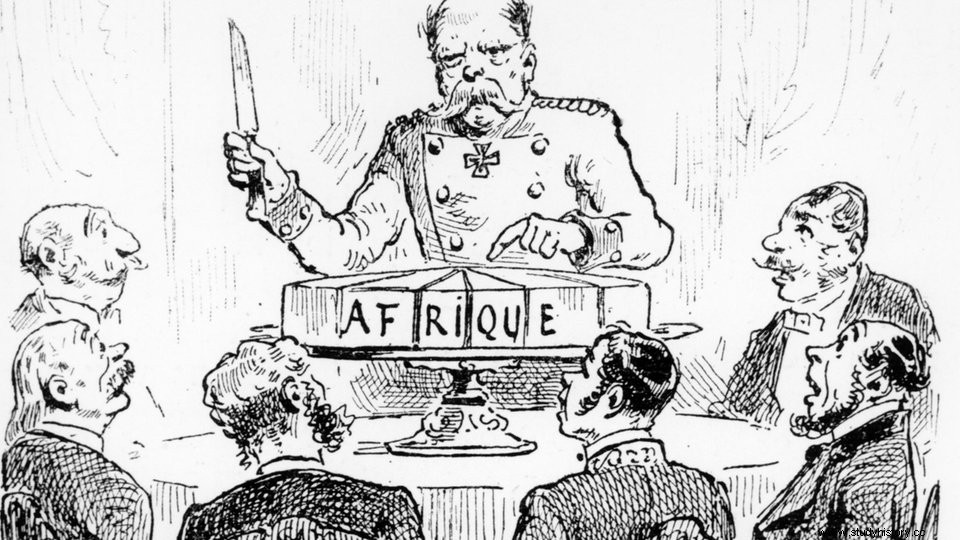
Congo Conference:Bismarck distributes the "cake" Africa
Germany as a colonial power
For a long time, Chancellor Otto von Bismarck refused to formally support German colonial policy. He did not see the young German nation-state as ready for colonial adventures and feared conflicts with the British.
But the German colonial associations became more and more aggressive and in 1884 they occupied so-called "protected areas" in Africa, including German Southwest Africa, Togo and Cameroon. However, they could not build up any colonial structures there on their own. In April 1884, Bismarck changed course. He placed German South West Africa under the formal protection of the German Empire. Germany entered the colonial age as one of the last European nations.
In the following years further areas were occupied, mainly in East Africa and on a few small islands in the Pacific. The Germans were extremely brutal in their colonization. In a short time they wanted to build structures that other nations had had decades or centuries to build.
This repeatedly led to uprisings in the colonies, which were crushed with all violence. In German South West Africa, for example, today's Namibia, German troops drove the local Herero into the desert and left them to die of thirst. From 1904 to 1908 more than 80,000 Herero died as a result of German atrocities. More than 100 years later, Germany officially recognized this crime as genocide in 2021.
The German colonial history was short-lived. With the defeat in World War I, the German Reich also lost all of its colonies. In the 1919 Treaty of Versailles, the victorious European states divided the territories occupied by Germany among themselves. After only 35 years, Germany's time as a colonial power came to an end.
 Start video, cancel with escape
Start video, cancel with escape The German colonial period
planet knowledge. 06/23/2022. 02:38 min. Available until 06/23/2027. WDR. By Hildegard Kriwet.
The beginning of the end of the British Empire
The First World War cost a lot of money. The British in particular felt this:the maintenance of their huge world empire devoured huge sums of money. In addition, the British in Europe also had to fight against the Irish, who wanted to assert their independence.
The Empire was no longer up to these challenges. In 1922, Egypt became the first African colony to gain formal independence from Great Britain after serious unrest. The British Empire began to crumble.
At the same time, the British Dominions - the four self-governing colonies of Canada, Australia, New Zealand and South Africa - were demanding more independence from the mother country. This led to the formation of the "British Commonwealth of Nations" in 1926, in which the Dominions were declared distinct communities within the British Empire. Thus, four other colonies were de facto independent of Great Britain.
During World War II it became even more difficult for the British to hold onto their colonies. The Japanese attacked British Malaya, Hong Kong and Singapore. Britain could no longer defend its colonies on its own. Only when the USA entered the war in 1941 and with the support of the Dominions of New Zealand and Australia could the colonies in the Pacific region be held. Although the British emerged victorious from World War II, their status as the leading colonial power was weakened.
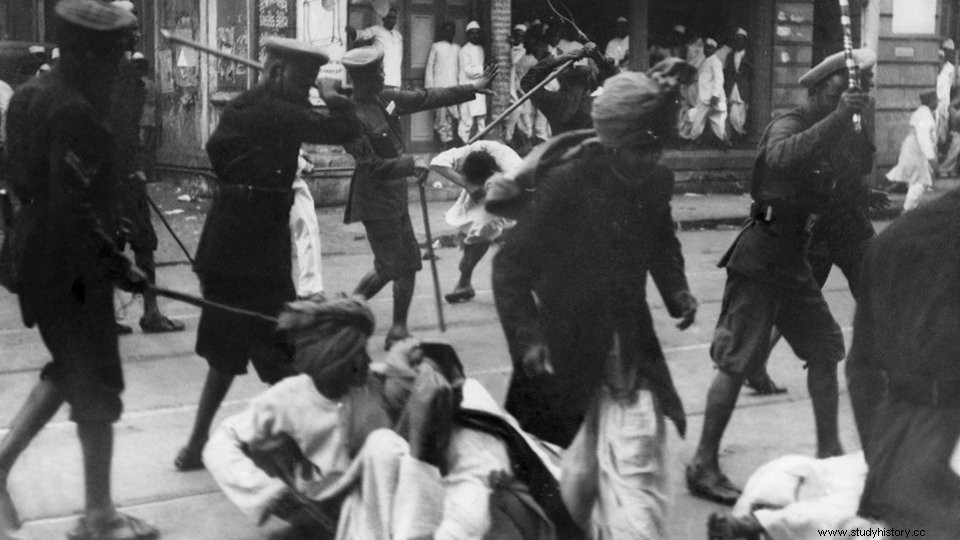
There was unrest in numerous colonies, like here in India in 1933
The Independence of India
India was at the heart of British colonial possessions, and so the British were not about to give it up easily. However, after World War I, when many Indians died in service with the British Army, calls for independence grew louder. A man named Mahatma Gandhi became the mouthpiece of the Indian people.
The charismatic Gandhi advocated an absolutely non-violent resistance. In 1920 he called for a campaign of non-cooperation:300 million Indians should no longer work with the 100,000 British in the country. But his campaign was initially unsuccessful. The initially non-violent protests by his supporters turned more and more violent and the country threatened to descend into chaos. Gandhi went on a hunger strike in 1922, which he only ended after millions of his supporters gave up the violent clashes.
In 1930 Gandhi expanded the campaign of non-cooperation into the campaign of civil disobedience. He called for the non-violent violation of British laws, for example by refusing the salt tax that the British levied on every pinch of salt. The campaign culminated in the legendary Salt March, where Gandhi and his followers demonstrated against the British salt monopoly.

Mahatma Gandhi became the symbol of the unarmed resistance against the British
Gandhi's patience paid off many years later:In World War II, more than two million Indians fought for Great Britain, and in 1941 Germany ended the air war against Great Britain due to high losses. In 1942, with England no longer directly threatened by the Germans, Gandhi demanded something in return for Indian support and declared India's independence. He was arrested shortly thereafter, but released two years later due to poor health.
The imprisonment brought Gandhi great sympathy among the population. Immediately after the war, Gandhi and Jawarhalal Nehru, who later became India's first President, fought for independence at the negotiating table. It was formally announced by British Prime Minister Clement Attlee in 1947.
Independence for most of Africa
After the Second World War, the victorious European powers, above all France and Great Britain, were still struggling severely with the consequences of the war. The reconstruction of the destroyed infrastructure was very expensive and there was a shortage of soldiers, as many of them had fallen during the Second World War.
In 1945 and 1947 there were unrest in the French colonies of Algeria and Madagascar, which were violently suppressed.
The start of the Algerian War in 1954, in which many soldiers died, and the lost war in Indochina (1946-1954) heralded a change in French colonial policy. Gradually, France withdrew its troops from the African colonies. Tunisia and Morocco were the first to become independent in 1956, followed in one fell swoop in 1960 by numerous colonies in West and Central Africa.
Unlike France, Great Britain withdrew from its colonies largely without a fight. The British government wanted to gradually hand over its colonies to moderate democratic governments. In 1957 Ghana became the first Central African country to become independent.
With the withdrawal of the British, regional conflicts arose in many colonies. However, these were largely ignored by the former oppressors when the colonies regained their independence in the 1960s – despite the arbitrary borders and smoldering conflicts.
Only Namibia remained under South African administration and only gained independence in 1990. Because the former "German South West Africa" had already been conquered by South African troops in 1915 and administered by South Africa after the First World War. After World War II, South Africa refused to give back its independence, leading to significant tensions with the UN.
The other European states pursued very different plans in Africa. While Italy, which had been shaken after the war, withdrew from Libya in 1951, Belgium occupied the Congo until 1960. Portugal only released its colonies in 1974 with the end of the fascist dictatorship.
The end of Portuguese colonial rule
Compared to other European countries, Portugal held on to its colonies for a very long time. While many voices in England, France and the Netherlands called for an end to colonial policy, a fascist dictatorship arose in Portugal in the early 1930s under Prime Minister António de Oliveira Salazar, which wanted to revive the once powerful Portuguese empire.
During World War II, neutral Portugal prospered by trading in produce from its colonies. But after the war, the Portuguese colonial empire also began to crumble.
In 1961 India occupied Goa, Damão and Diu. In Africa, in the early 1960s, there were armed uprisings by the local populations in Guinea, Mozambique and Angola. Although Portugal gradually improved the living conditions in the African colonies under this pressure, it could no longer stop the development.

In the 1960s, resistance formed in the Portuguese colonies
On April 25, 1974, the Portuguese army turned against the fascist dictatorship in the home country. The population was enthusiastic. In an atmosphere reminiscent of a folk festival, people on the streets put carnations in the gun barrels of the soldiers. The peaceful uprising went down in history as the "Carnation Revolution". The fascist government was overwhelmed by the overwhelming mood in the country and capitulated.
A year later, the newly elected democratic government was the last European state to withdraw its troops from the colonies. The Portuguese colonial history of more than 500 years was over.
The end of apartheid in South Africa
On May 9, 1994, a dream came true for many South Africans:Nelson Mandela became the country's first black president in free elections.
Although the 20th century was well advanced, a freely elected president was something special in the country of the Cape. Until then, the country had been dominated by the Boers, the white population originally from the Netherlands. For decades they had vehemently opposed all attempts to give black people more rights.
South Africa became independent from Great Britain as early as 1926 as one of the four self-governing colonies ("Dominions"). The government of the new state was to a large extent determined by the nationalist and racist Boer National Party.
Already at the beginning of independence, the Boers tightened many laws to the detriment of blacks. Step by step, more and more living space was taken away from the black population, the right to vote was withdrawn and opportunities for advancement were blocked. The situation worsened when the racist "National Party" came to power in 1948. She pursued a strict racial segregation between white and black population - the so-called apartheid.
Despite international protests and economic boycotts, the National Party held on to power for more than 40 years. Only the country's last white president, Frederik Willem de Klerk, pursued a more liberal policy from 1990 onwards. He released the long imprisoned civil rights activist Nelson Mandela from prison and was ready to begin talks with the black population. The last colonial system that deliberately treated its inhabitants unequally was coming to an end.
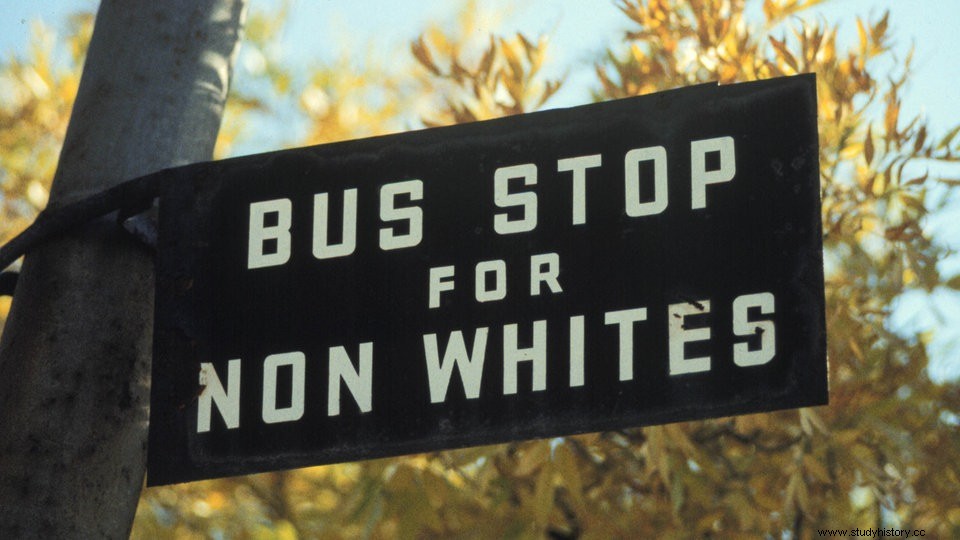
There was also a strict separation between races at bus stops
Hong Kong's return to China
In July 1997, Great Britain handed over the Hong Kong colony to China with a huge fireworks display that shone out over the entire skyline of the metropolis. 155 years of British rule on Chinese soil were over.
Hong Kong fell to the British in 1842 after defeating China in the Opium War. In the "Treaty of Nanking" the Chinese emperor had to cede Hong Kong to the British "for ever and ever". In 1898, the British leased the surrounding areas and islands for a further 99 years, the so-called "New Territories". And it was precisely this lease that gave China a decisive advantage in the 20th century.
In the 1980s, the two countries entered into negotiations as Great Britain wanted to extend the lease. But China strictly rejected this. As Hong Kong would not be viable on its own without its surrounding areas, British Prime Minister Margaret Thatcher finally gave in. Hong Kong was returned to China as the last remaining colony of the British Empire when the lease expired.
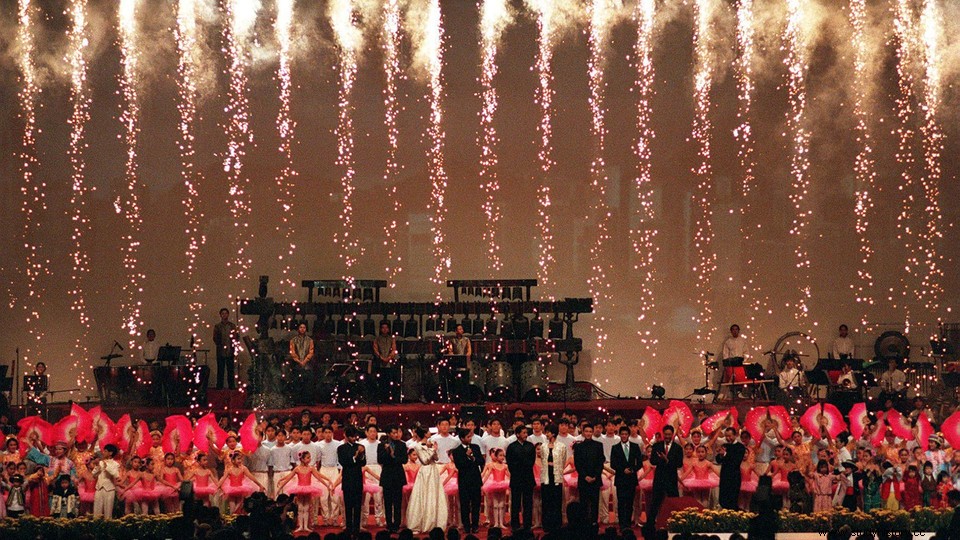
1997 Hong Kong becomes Chinese again
